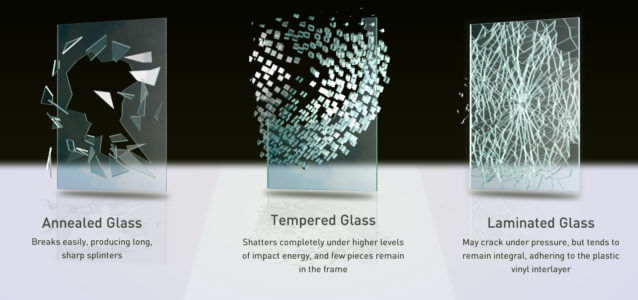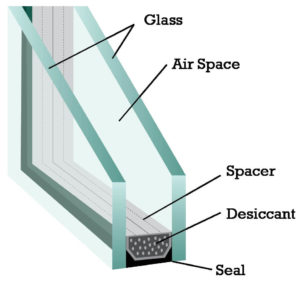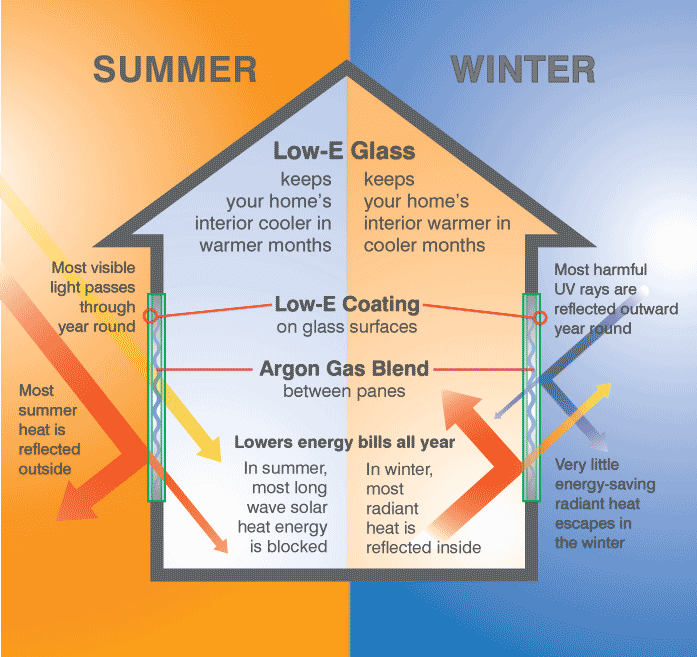Annealed Glass (Non-Safety)
Annealed glass is a piece of float glass that has been cooled in a slow and controlled manner. This slow cooling process is designed to make the glass stronger by reducing the internal stresses within the sheet of glass. As highlighted in the picture to the right, when damaged annealed glass will break into large and sharp shards or pieces.
Because of these safety concerns, annealed glass is almost never used in buildings. If a window glass company intends to install the glass in very low traffic areas that are hard for anyone to touch, annealed glass might be sufficient.
Annealed vs. Tempered vs. Laminated
Tempered Glass (Safety)
Tempering is a process commonly used to make annealed glass up to four times as strong. After the original annealed glass is cut and finished to size (tempered glass can’t be cut), the annealed glass is heated past its annealing point of around 1200 degrees Fahrenheit.
The glass is then rapidly cooled, which allows the internal portion of the glass to remain fluid for some time. Since the center stays fluid longer than the outer surfaces, an equal amount of tensile and compressive stresses are formed across the glass. This makes the tempered glass significantly stronger than the original annealed glass.
Fully tempered glass is one of two kinds of safety glass commonly used in applications in which standard glass could pose a potential danger. The brittle nature of tempered glass causes it to shatter into small oval-shaped pebbles when broken. This eliminates the danger of sharp edges that usually occur when annealed glass is broken.
Laminated Glass (Safety)
Laminated glass is the other type of safety glass that is regularly used in places where safety is of the utmost importance. Laminated glass is typically made by fusing two or more layers of glass with inter-layers of polyvinyl butyral (PVB) through the use of heat and pressure. This process creates a safety glass.
Laminated glass made from sheets of heat strengthened glass will break into large pieces when damaged, but will be held in the frame by the PVB inter-layer. This feature provides some safety, but also adds a level of security since the glass remains in place and prevents anything from passing through it.
If the laminated glass is made using sheets of tempered glass, then the sheet will fall out of the frame when damaged, but will mostly stay together due to the PVB inter-layer.
Laminated glass is best used as a safety glass when the glazing of the window glass must remain intact when broken. For example, most car windshields are made of laminated heat-strengthened glass so in the instance thatan object hits it, the object won’t pass through and injure the driver or passengers nor will the glass shatter into the faces of the vehicle occupants.
Insulated Glass Unit (IGU)
Insulated glass units (IGU) are assemblies where two or more pieces of glass are separated by spacers. Two pieces of window glass separated by one spacer is commonly referred to as double-glazing. Triple-glazing (three sheets of window glass separated by two spacers) is becoming more and more common nowadays. You will find both options usually available at a reputable window glass company.
The spaces between the pieces of window glass is typically filled with air or some other type of inert gas, such as Argon. Argon is by far the most commonly used inert gas in IGUs, but Xenon and Krypton are way more efficient (and significantly more expensive).
The sheets of glass are tempered or laminated for safety, and are generally 1/4″ thick with a 1/2″ air space. The most critical component of an Insulated Glass Unit is the desiccant, which effectively removes humidity from the cavity to prevent condensation within the IGU.
Double-glazed Insulated Glass Units made from 1/4″ glass and a 1/2″ space filled with air have an R-value of around R-2. IGUs using Argon gas raises the R-value to R-3. Further changing the glass to Low-E can take the assembly to an R-value of R-4. And finally, a triple-glazed IGU can have a value of R-5 or even higher.
IGU Diagram
Heat Strengthened Glass
Heat strengthened glass is made when a sheet of annealed glass is reheated beyond beyond its annealing point of about 1200 degrees Fahrenheit and then cooled rapidly, just not as rapidly as tempered glass. Since the glass is not cooled as quickly, the compressive and tensile stresses are not quite equal across an entire section of glass.
As a result, the glass is only about twice as strong as annealed glass (vs. tempered glass which can be over 4x as strong as annealed glass). Heat strengthened glass will break into much smaller pieces than annealed glass, however these pieces may still be sharp and still may cause injury. For this reason, heat strengthened glass is not considered to be safety glass. Heat strengthened glass is rarely used in buildings except in cases when it is laminated.
Heat Soaked Tempered Glass
Heat soaking is a method of testing tempered glass for unstable nickel sulfide inclusions, which are imperfections in the glass that may cause spontaneous breakage of the pane. The panes of glass are put into an oven and heated to a temperature of around 550 degrees Fahrenheit for a few hours. This causes any nickel sulfide inclusions to expand disproportionately to the glass, which makes the glass break.
The idea is to force any unstable glass panes to break before they have a chance to fail in the field. This can be quite important where the glass pane is critical for safety – for instance, in a glass railing. Of course, the process increases the cost of the glass panes. It is important to note that heat soaking is not a perfect process and it will not eliminate incidences of spontaneous breakage, but it will catch most of them.
Low-Emissivity (Low-E) Glass
Low-emissivity glass, commonly known as Low-E, is glass that has a special coating that reflects the infrared portions of light all while letting the visible light spectrum through. This core feature is beneficial because the infrared heat from the sun is ultimately reflected away from the house in the summer and during the colder winter months the infrared heat that is already inside a house is reflected back into the space.
Tin and silver are the two most common types of Low-E coating. In the case that tin is used, tin oxide is applied to the window glass at high temperatures to create a very hard and durable Low-E coating. The other option is a silver coating, which must be enclosed in an Insulated Glass Unit so that the silver does not degrade over time because of oxidation.
Low-E coatings usually have a slight blue-green tint, which many architects (and window glass company) find very unappealing. Newer Low-E coatings are produced with less of this tint, but it is extremely important to review Low-E product samples in daylight at varying angles to fully understand what they will look like when installed.
Wire Glass
Most people believe wire glass is stronger than annealed glass, however, this is not the case. Wire glass is actually less strong than annealed glass primarily because the integrated wire disrupts the continuity of the glass structure. Wire glass is definitely not considered to be a kind of safety glass.
Wire glass is best known for its fire resistant property in which the wire holds the glass in place if the glass shatters due to excessive heat. Additionally, the wire will hold broken glass in place under the pressure of a fire hose. In high temperatures, the wire holds the glass in place better than the PVB films used in laminated glass.
Float Glass
Float glass gets its name from the modern process used to create large, thin, flat panels from molten glass. The molten glass is passed onto a pool of molten tin. This process produces a very smooth piece of glass with a highly consistent thickness.



